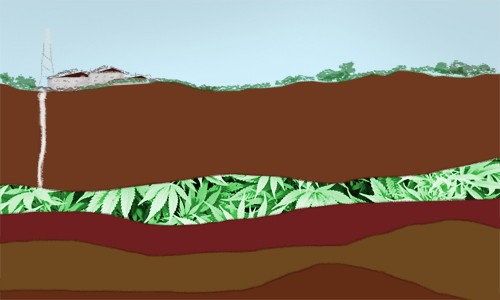Lest we forget
In memoriam of the Ganja Mine: 2000-2009
Lately, it seems like every day brings news of another celebrity death. It started in June with David Carradine. Since then, Arturo Gatti, Billy Mays, Ed McMahon, Farrah Fawcett, Koko Taylor, Michael Jackson and the Taco Bell dog have all gone to join the Great Gig in the Sky.
So let’s take a moment to remember the Flin Flon grow-op.
Since 2000, an unused mineshaft 600 km northwest of Winnipeg and 1,000 feet underground has been growing the only government-approved marijuana in the country.
As of June 30 however, Flin Flon’s fabled Ganja Mine is no more.
Earlier this year, HudBay Minerals announced that it would be shutting down its operations in the area by 2010. Since HudBay owns the mineshaft which biotech firm Prairie Plant Systems Inc. operates out of, when the mining shuts down, so does the farm.
Security was never an issue in Flin Flon. The dope mine boasted unparalleled safety measures: Cameras, motion detectors, security guards, reinforced steel doors at least 1/4 inch thick. The site was categorized as Class-8 Secure; security so tight that by government standards, $31,000,000 worth of illicit drugs could be stored without any problems. And Prairie Plant’s first contract with Health Canada was worth just $5.3 million over a period of seven years.
Inside this fortified bunker, a small team of anonymous employees worked in low-rent HAZMAT gear. Their uniforms included white jumpsuits, gloves, face masks and hardhats. Staff looked as though, rather than growing a plant for Health Canada, they were cooking up batches of crystal meth for the local Hell’s Angels.
Flin Flon’s grass didn’t benefit from the prison-style security or being treated like biohazardous waste. Footage from inside the mine showed sickly, stunted, brown-tinged plants. Stems and seeds were often found mixed into the final product, as if Prairie Plant was throwing everything they had into a big wood-chipper and delivering whatever came out the other side.
The cost of this gritty, hideous mulch was set at $5 per gram, plus taxes. The price must have been too high for most, since only one in five medical marijuana users would smoke anything that came out of Flin Flon. The rest opted to grow their own at home, or buy from, shall we say, more traditional sources.
Over nine years, Flin Flon’s grow-op turned into something failed and ugly. Its legacy will ultimately be this: Shitty weed grown by faceless, nameless government contractors in a dirty abandoned mineshaft. Wherever Prairie Plant Systems moves now, rest assured that things can’t get much worse.
Yet in a way, it’s sad to see the Ganja Mine go. After all, for the past decade, Manitoba was host to the Medicinal Marijuana Capital of Canada. Now, that honour will almost certainly leave the province. Without it, all we have to brag about are homicide, car theft and Slurpees.
More importantly though, Flin Flon’s grow-op stood as a reminder – however small or distant it may have been – of a time when Canada was still toying with ideas like decriminalizing (maybe even legalizing) marijuana. Those days seem like ancient history now. Flin Flon may have been our last link to those days…
So, I hope you’ll all join me in taking a moment to honour the memory of the Ganja Mine in whichever way you feel is most suitable.
Published in Volume 63, Number 30 of The Uniter (August 13, 2009)








